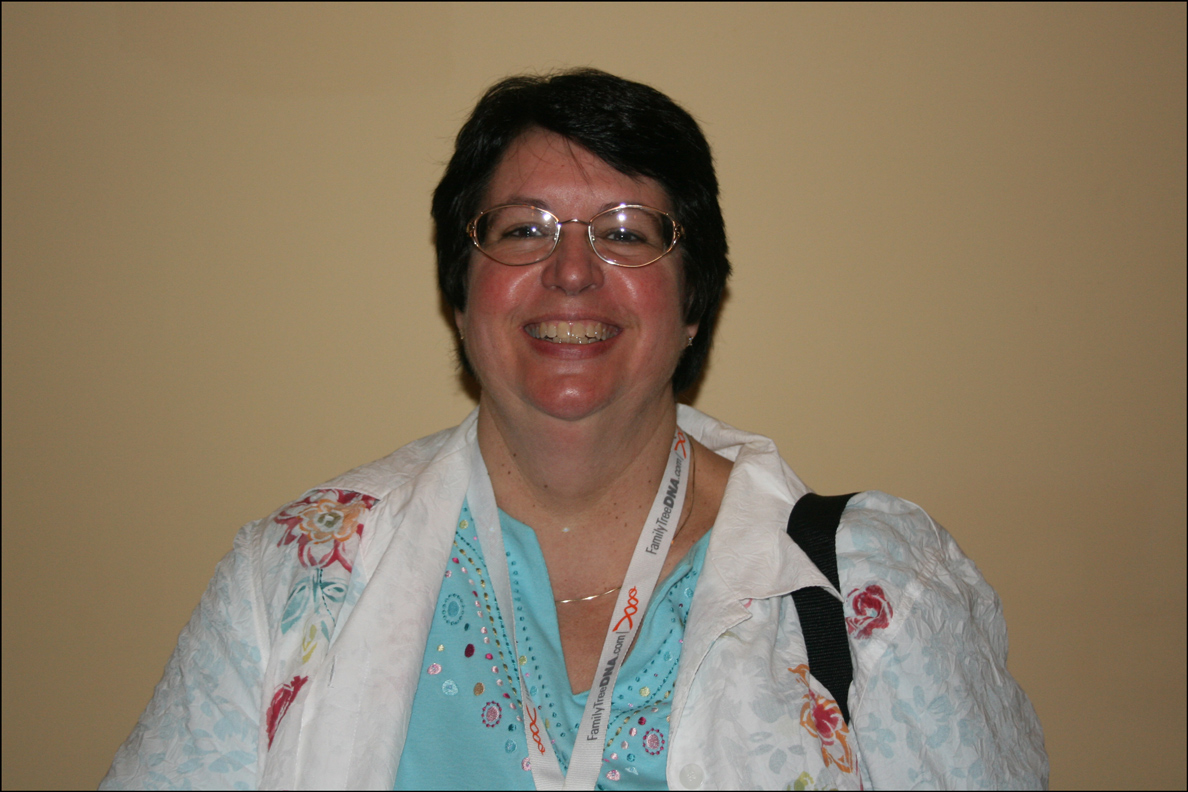On Saturday, March 14, 2009, Roberta Estes delivered a presentation entitled “Where Have All the Indians Gone” to members of the International Society of Genetic Genealogy (ISOGG) who were present for the Family Tree DNA 5th International Conference on Genetic Genealogy for Project Administrators.
Roberta Estes
SOURCE: Roberta Estes (Houston, Harris County, Texas). Photographed by Stephen J. Danko on 14 March 2009.
In her talk, Roberta discussed the fate of Native Americans and their DNA after the arrival of Europeans in the Americas.
The Melungeons arrived in Claiborne/Hawkins Counties in about 1800. In a trial over voting rights, the Melungeon claimed they were “not Negro”, but rather Portuguese and Indian. The decision of that trial was in their favor, but recent analysis of Melungeon DNA reveals that their core DNA is European and African, with no native haplogroups. All mtDNA samples are European.
The Lost Colony was the first known prolonged contact between Europeans and Native Americans. The colonists may have survived by being assimilated into native tribes. Research into the Lost Colony has resulted in a database with over 5000 entries and a timeline of over 1000 pages.
Beringia, the exposed land between Alaska and Siberia over which man is thought to have first entered the Americas created a bottleneck at the end of the last glacial maximum. The genetic groups in the Americas became isolated, resulting in Y-DNA haplogroups of C3 (rare), Q3 and M3, and mtDNA haplogroups of A2, B2, C, D, and X2a.
Native American tribes can be grouped into language families: Iroquoian, Algonquin, Siouan, and Muskhogean (east of the Mississippi). Virginia and North Carolina included three of the four language families.
Some large Native American tribes disappeared completely. The South Carolina tribes are all gone, although the Shawnee survived. Losses were due to intertribal warfare or warfare with the colonists, disease, the emerging slave market, and alcohol.
The result was that there were not enough males to sustain the tribes, and non-native Y-DNA was introduced into native populations.
In Bolnick, D.A., D.I. Bolnick, and D.G. Smith. 2006 Asymmetric Male and Female Genetic Histories among Native Americans from Eastern North America. Mol. Biol. Evol. 23:2161-74, the authors calculated 47% non-native DNA in families believing to be no less than 75% native.
Copyright © 2009 by Stephen J. Danko





The South Carolina Tribes are not all gone. This should be re-written to represent the correct information. The Catawba are still there, the Pee Dee and several other tribes as well as their descendants are there and are recognize by the United States government (Catwaba) as well as the state of SC (Pee Dee and several others). This over generalization should not be made without the proper research. It is disrespectful to our people to say the least.
South Carolina Indian Haplogroup A2n.
Thank you.
I apologize if you thought my post on Roberta Estes’s lecture was disrespectful. I did not intend any disrespect. My post only describes the lecture presented by Roberta Estes at the 2009 FTDNA Conference. I have not conducted any independent research and I have not attempted to verify anything that Roberta Estes said in her lecture. I have attempted to be as accurate as possible in reporting what was said, although it is possible that some things may have been taken out of context. Please contact Roberta Estes directly to clarify exactly what she meant. Indeed, the United States Government recognizes the Catawba Indian Nation and the State of South Carolina recognizes the Beaver Creek Indians, the Pee Dee Nation of Upper South Carolina, the Pee Dee Indian Tribe of South Carolina, the Santee Indian Organization, the Waccamaw Indian People, as well as six Native American Indian Groups and one Native American Indian Special Interest Organization. I do not know the basis for governmental recognition of a tribal group and I do not know the basis for Roberta Estes’s comment.
I wonder exactly where the names for her research are really coming from, considering the lists of the colonists and their ancestors would be needed to fully understand this research. In addition, there were other foreigners who were shipwrecked in the area as well, possibily leaving their seed here. In addition,
as far back as Pardo, as we haved record, there were whites/spanish coming in and raping and taking Indian women. How does she think she could possibily narrow it down under all of those scenarios. There are documents that prove the Berry’s left ancestry here. Is she using those? I may be naive, but I am a little baffled by this undertaking and would be skeptical of any results found due to the amount of history she would need to verify any results.
Hi Angie,
Thanks for your comment. I am sorry, that I don’t personally have the answers to your questions. To find out more about Roberta Estes’ research or conclusions, I would suggest that you contact her directly. I have found two email addresses for her: roberta@dnaexplain.com and robertajestes@att.net . She is very friendly and willing to discuss things with people. You can read her entire paper on “Where Have All the Indians Gone?” at http://www.jogg.info/52/files/Estes1.pdf .
Best regards,
Steve Danko
Hi my mothers name us Mary jo Estes farther name is John Washington Estes im looking for my family